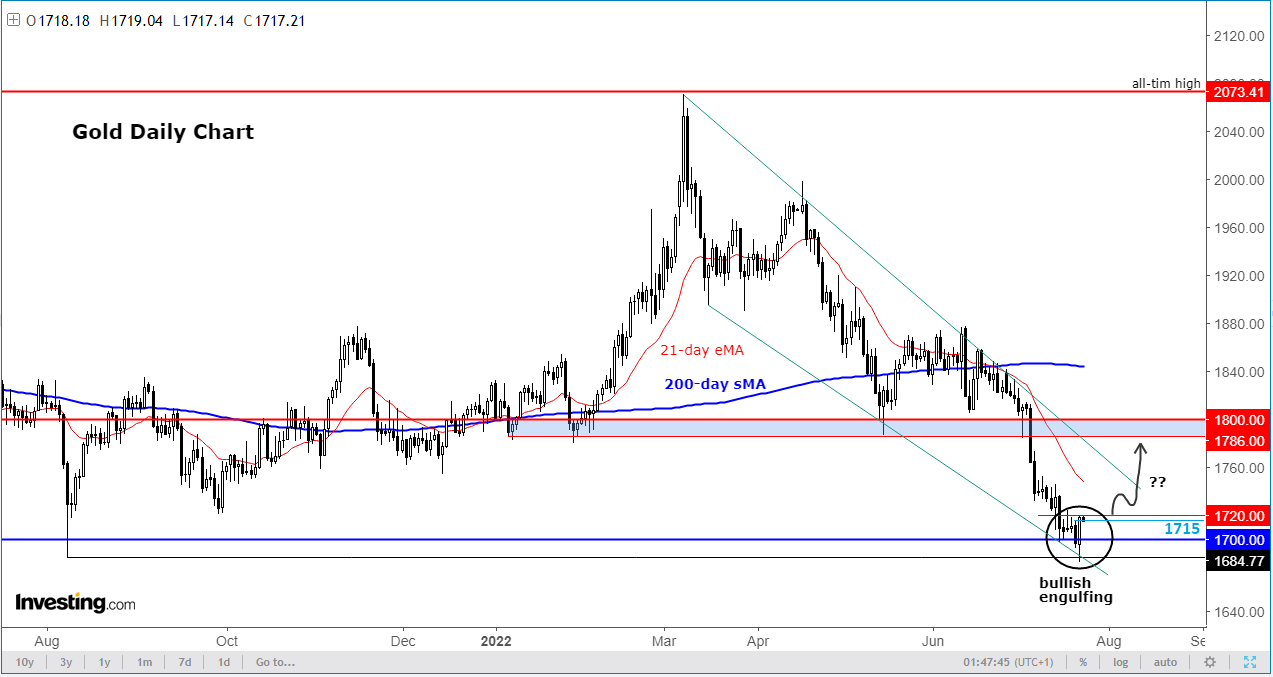- Gold prints potential reversal candle pattern
- Yields drop as recession concerns mount
- Gold may be able to rise towards $1800
Gold is in focus today after Thursday’s bullish price action as fresh macro data sounds recession alarm bells. We have seen bond yields drop sharply, with the dollar rally also stalling with the Dollar Index being lower on the week despite a small recovery this morning.
Although still lower on the session at the time of writing in the early hours of Friday, gold looked set to extend its recovery following this beautiful price action on Thursday:

The metal fell below long-term support around $1700 on Thursday before surging back higher to not only turn positive on the session but rise above Wednesday’s range too. It, therefore, created a bullish engulfing candle on the daily chart. Silver also formed a similar candle.
A bullish engulfing candle, as the name suggests, is a strong bullish reversal pattern and is typically found at the end of a downtrend. It is a two-bar pattern, with the range of the first being completely engulfed by the range of the subsequent candle. It shows a clear shift from selling to buying pressure.
The above bullish engulfing candle on the daily chart of gold may be a signal that the metal has bottomed out—or at least created a short-term low. As a minimum, I now expect the metal to rise towards the resistance trend of its bear channel/wedge. But there is the possibility of an even larger comeback towards the next zone of resistance between $1786 to $1800, and possibly higher.
Gold has until now been unable to shine because of the strength of the US dollar and rising interest rates. However, given that recession concerns are on the rise, as highlighted by the latest economic data, we could see the market start to focus on peak inflation and the end of the tightening cycle.
Remember the markets are forward-looking and while it may be too early to talk about rate cuts, it is possible that much of the rate hikes are now fully priced in.
Continuing with the recent trend, this morning saw the latest Eurozone PMIs disappoint, with the Composite PMI slipping to contraction with a print of 49.4, down more than 2.5 points from 52.0 recorded in June.
Manufacturing sector activity (49.6) was hit the hardest, while services stagnated as the PMI dropped to 50.6 from 53.0.
In the US, we saw the Philadelphia Fed Manufacturing Index drop to -12.3 compared to an expectation of -2.5 and a previous print of -3.3. Meanwhile, the number of Americans signing up for unemployment benefits rose to an 8-month high.
Let’s see whether the US PMIs also point to recession, when they are released later this afternoon.
Disclaimer: The author currently does not own any of the securities mentioned in this article.
